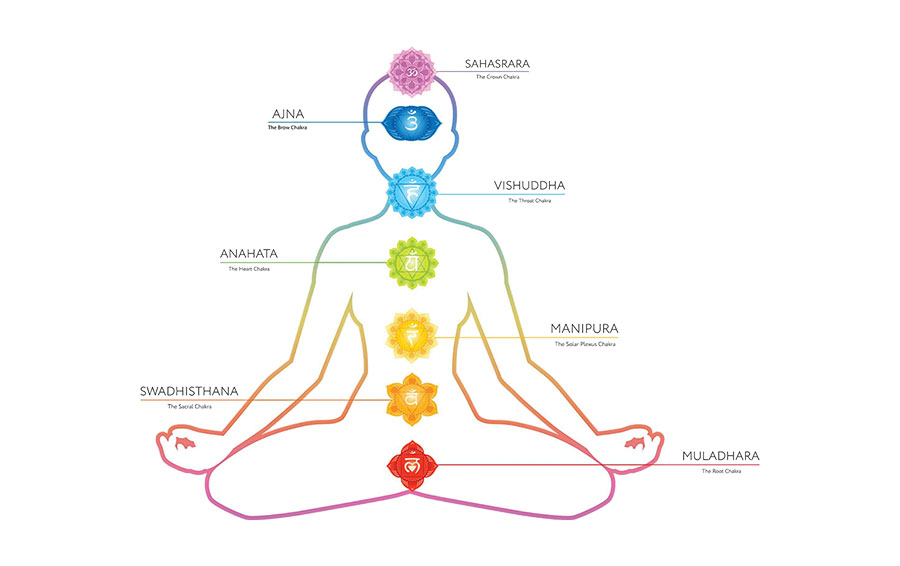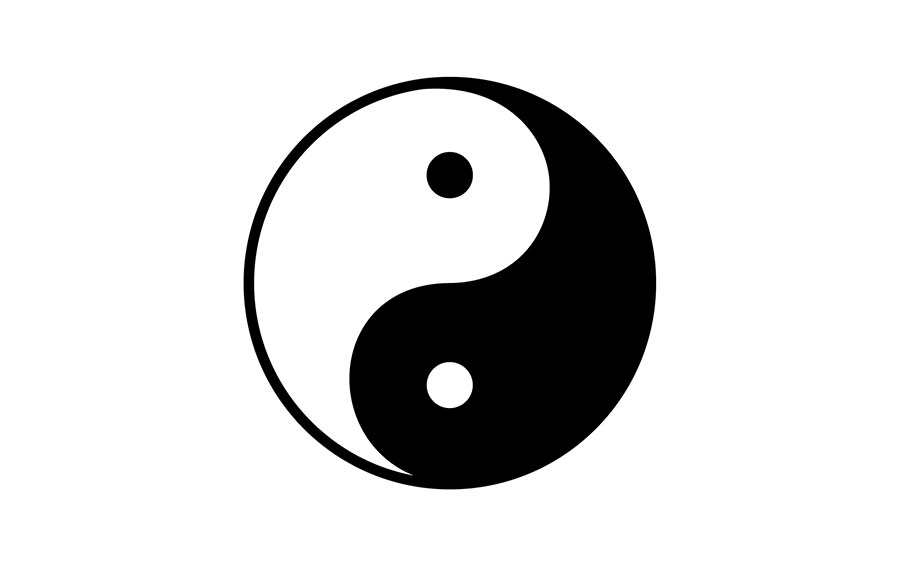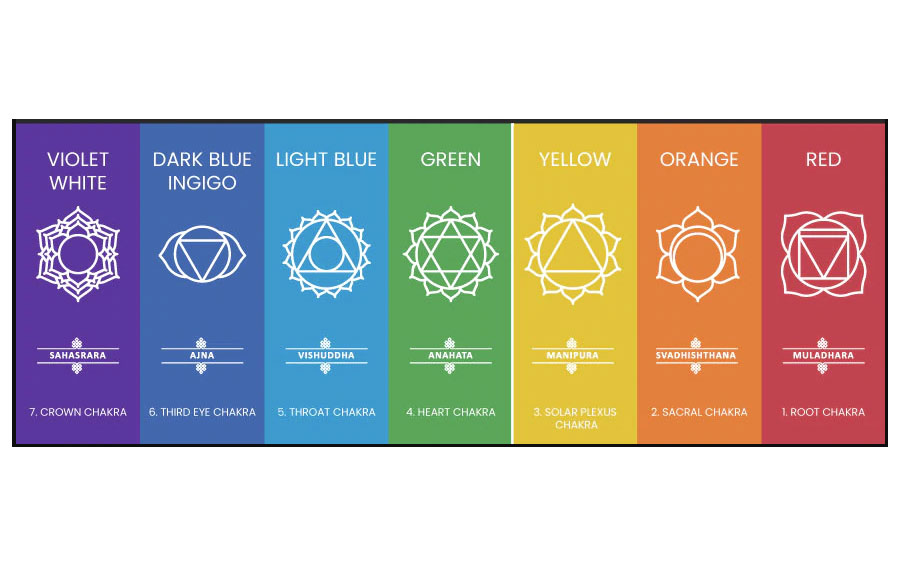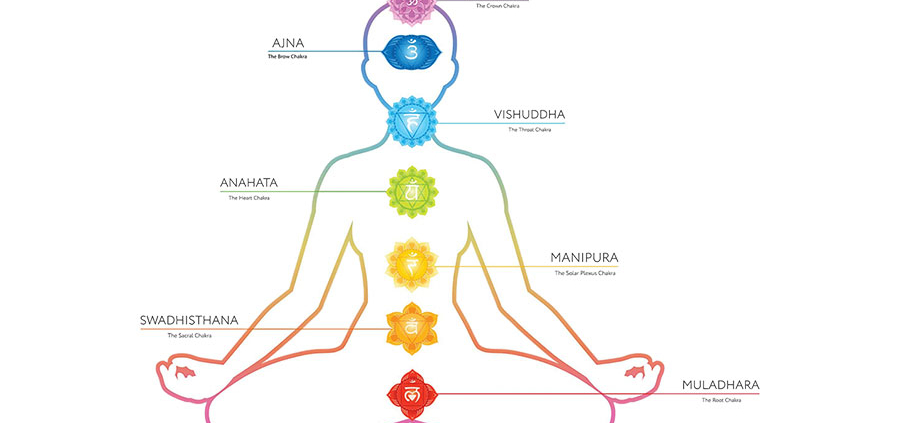Chakras and Their Meanings
One of the most intriguing – and challenging – topic in tantric yoga is the concept of chakras. Many people talk about them, equally many have an opinion about them – but do we really know? Some people claim that we have 12 chakras, while some claim they only have three of them. Do they spin, or do they look like lotuses? Can someone really see them? What does it matter, or does it matter at all?
In this article I try to shed light on this mysterious subject of chakras and their meanings – and how you can apply this knowledge to your daily life.
This article grew so long that I decided to split it in to two parts. Stay tuned to read the more practical descriptions of each chakra and how to work with them!
What is a chakra?
Probably the most common and wide-spread idea is that we have seven chakras, or energy centers, in our body. Here we already face the first problem: if the chakras are in our body, why they can’t be physiologically found? Where would they be located? And what do they do?
The word chakra means a wheel, so it is understandable that it has created an idea that chakras would be spinning one way or the other. According to the traditional sources, however, it seems that chakras would not actually spin, but rather the wheel describes the shape of this energy center. In many diagrams you could see that chakras are described as vortexes, looking a bit like a tornado.

tantra Chakra
Chakras act like an antenna, with which you can connect to the various energies of the universe. It’s how you can tune your body – microcosm – to resonate with the universe, the macrocosm. These antennas work both ways: we can either receive the energy through them, or we can send energy out through them. We call it polarity: a negative and a positive, or receptive and emissive or yin and yang.
While from the descriptions of chakras in the next part of this article it may become apparent on which side the problem may be, it’s still better to do balancing practices and not to try to boost one at the cost of another.
The chakras are located in our subtle energy body, and they have corresponding locations in our body. They are said to be a couple of centimeters outside of our physical body. The chakras are connected to the central channel, sushumna nadi, which runs along our spine. The three main nadis – ida, pingala and sushumna – start from the Muladhara chakra. There are countless other nadis in our bodies, and the energy received through the chakras is distributed through this network of subtle energy channels. This is a reason why it is important to keep your body pure and avoid toxins. Open and flowing energy channels will help us accessing the universal energies available to us, everywhere and all the time.

In addition to the main chakras, there are several secondary chakras, which operate like sub-ordinates to the main chakra. Sometimes this can be more direct way to affect the chakra we want to work with.
Each of the chakras have a designated number of spokes or petals, if we use the lotus symbolism. The number of petals indicates the frequency of this particular chakra, so we see that the lower chakras are running on a lower frequency than the higher ones. The root chakra Muladhara has four petals, while Ajna, the Third Eye, would have 96 spokes.
The frequency would also correspond to the frequency of our subtle bodies, which run from the material, physical body to the most subtle bliss-body that can only be perceived in a very high states of consciousness. Some also say that the number of spokes indicates the number of nadis connected to that particular chakra.
Traditional sources on chakras
The most common and widely cited resource on the chakra system known today comes from the book The Serpent Power by Arthur Avalon, or Sir John Woodroffe. He was a British judge who was working in Calcutta when he got interested in traditional tantra and tantric philosophy. He was initiated to tantra, and he was translating some of the ancient texts to English, for the first time.
The Serpent Power is a direct translation of two traditional texts, Sat-chakra Nirupana (Description of the Six Centers) and Padukapanchaka (Fivefold Footstool), with a long and highly informative introduction of 300 pages! You can easily find the book online, for example here.
There was a small problem with his interpretation, however. While he was translating the text for The Serpent Power, he was not aware that the text he was translating was only a small part of a larger body of text. With this information, he understood that the chakra system he was describing in his book was actually relating to the human body, while the original text was referring to the chakra system as a cosmological order of affairs.
Another often referred book on chakras is from the 1920’s: The Chakras by Charles Leadbeater. This also is available online. He explains his interpretation on chakras based on his own experiences through clairvoyance. In his opinion, everyone can learn to see chakras if we learn to tune in to more subtle frequencies than we normally are used to perceive.
It is said that most of the current information and theory of chakras is coming from these two sources from the beginning of last century. In addition, at least some of the psychological attributes of chakras come from the famous psychiatrist Carl Jung, when he offered his interpretation of the qualities of chakras on some of his lectures he gave at around that same time.
Levels of consciousness connected to the chakras
The following chapter is from the Gospel of Sri Ramakrishna, where he explains how the chakras are related to the seven planes of existence. It is beautiful description of the evolution of our consciousness, the workings of tantric yogi path.
The Vedas speak of seven planes where the mind dwells. When the mind is immersed in worldliness it dwells in the three lower planes – at the naval, the organ of generation, and the organ of evacuation. In that state the mind loses all its higher visions – it broods only on ‘woman and gold’.
The fourth plane of the mind is at the heart. When the mind dwells there, one has the first glimpse of spiritual consciousness. One sees light all around. Such a man, perceiving the divine light, becomes speechless with wonder and says: ‘Ah! What is this? What is this?’ His mind does not go downward to the objects of the world.
The fifth plane of the mind is at the throat. When the mind reaches this, the aspirant becomes free from all ignorance and illusion. He does not enjoy talking or hearing about anything but God. If people talk about worldly things, he leaves the place at once.
The sixth plane is at the forehead. When the mind reaches it, the aspirant sees the form of God day and night. But even then a little trace of ego remains. At the sight of that incomparable beauty of God’s form, one becomes intoxicated and rushes forth to touch and embrace it. But one doesn’t succeed. It is like the light inside a lantern. One feels as if one could touch the light, but one cannot on account of the pane of glass.
In the top of the head is the seventh plane. When the mind rises there, one goes into samadhi. Then the Brahmajnani directly perceives Brahman. But in that state his body does not last many days. He remains unconscious of the outer world. If milk is poured into his mouth, it runs out. Dwelling on this plane of consciousness, he gives up his body in twenty-one days. That is the condition of the Brahmajnani. But yours is the path of devotion. That is a very good and easy path.
Elements, the building blocks of everything
The first five chakras are connected to a certain material element or a tattva: earth, water, fire, air and ether, from down up. This information can be useful when learning how to work with specific issues. For example, if you often feel ungrounded and lacking of vitality, through this mapping you could tune to the earthly energies and work with the Muladhara, or Root chakra. Or if you would be lacking drive, you could seek help from the energy of the Sun through Manipura chakra.
The sixth chakra, Ajna, corresponds to mind energies, both on the Universal and personal level. Sahasrara, the Crown chakra, corresponds to the absolute. It is different from the other six chakras, as it is rather an independent unit working in unison with all the other chakras.
Colors of the rainbow – or not?
The most common idea of the colors of the chakras is the rainbow-like spectrum, ranging from the warm red of Muladhara to a purple of Sahasrara.
The colors of the chakras in The Serpent Power are all different kinds of red and purple: crimson, vermilion, “radiant like the rising sun”, “red like bandhuka flower”, smoky purple hue, white…

chakra color
In my understanding, there can be several colors and shades of colors that can resonate with each chakra. So the way to work with this could be done through experimenting: once you get more tuned in to your subtle body and its sensations, you could feel for yourself how the different colors affect your being.
One explanation why specific colors could not be assigned to chakras is that the first five chakras belong to the sensible or perceptible world, while Ajna and above belong to the mental realm, and Sahasrara is even beyond that. So all the frequencies of colors should fit already to the first five of the chakras. It’s the same principle with the sounds.
Sounds of the universe
In a similar manner to the elements and colors, chakras have mantras connected to them. These are called the bija mantras. Some sources say that bijas should not be repeated lightly or without initiation, or not understanding their proper functioning. It is also said that you need to be able to repeat the bija mantra with a proper pronounciation for them to be effective, and even then, a mental repetition may be a better way to work with them.
Paul Russill is a spiritual teacher and a musician who had intensely worked with healing sounds and has researched the bijas as well. You can listen to his interpretation of the bija mantras from Spotify, and he has written an interesting book on the topic of healing with sounds and mantras, The Yoga of Sound.
I mentioned that it may not be accurate to assign a specific frequency to a chakra. However, there can be certain types of music and instruments that can resonate with the chakra in question. I will give some examples of such music in the next part of this article. In the meantime, you could tune in to your Ajna chakra by practicing Mantra Meditation with the mantra AUM.
Physical correspondence
The Western scientic-materialistic mind has tried to assign the chakras to the various nervous plexuses in our body. The chakras are located outside the physical body, so in this way they do not directly relate to any physical organ.
This said, they do have an effect on various functions of our body, especially the hormonal function. In the next article I’m going to dive deeper in to this and explain more of this connection.
In Chinese Medicine and acupuncture, the main role is on the meridians and the flow of chi in the body. The nadi and chakra systems are certainly related, and there are a lot of similarities between the two systems. I’m not too familiar with their tradition, so I can’t say much more about it.
Conclusion of the first part
The amount of information can easily become overwhelming when trying to make sense out of fascinating topic of the chakras. This happened to me as well while trying to decide what I should write here and what not.
When I first learned about chakras, it was through the work of Barbara Brennan. I did energy healing at that time, but somehow it was out of context and I did not really know what was happening in a healing session. The people I was working with reported positive results, but I wanted to understand what I was doing. So eventually I gave it up.
It was only through my interest to tantric yoga that this dormant information started to make sense again, and I got many answers to my questions as where this information is coming from, what can be done with it and most importantly, how to work with it. This I will write about in the second part of this article.
Unfortunately I have not yet learned how to see chakras. A practice of trataka should be helping with this.
If you have any questions about chakras and this brief introduction to the topic, leave your comment below and I will be more than happy to respond!





